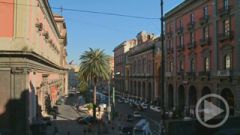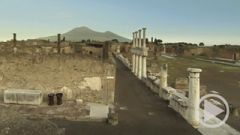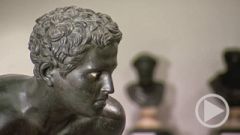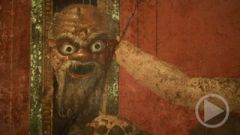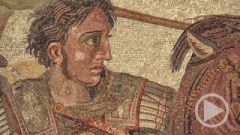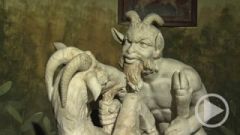The Farnese Collection and the History of the Museum
The Farnese Collection and the History of the Museum
In 1534 Alessandro Farnese, scion of the old aristocratic family was elected Pope. As Paul III, he was notorious for his nepotism; the first cardinals he appointed were his own grandsons. Even before his election Farnese had been a great collector of classical artworks. As Pope he continued to amass Greek and Roman antiquities. In an edict of 1540 he claimed the exclusive rights to all excavations in Rome for the Vatican. And all recovered artifacts become his personal property. Paul’s descendents went on collecting and over the next two centuries the works accumulated in the family’s palaces to become an immense treasure-trove of classical art – the “Farnese Collection“.

The Farnese were not collectors out of scholarly interest. The statues had a representational function: the family members placed themselves in the grand tradition of antiquity. Not surprisingly, they were particularly fond of Roman emperors – whose portraits are now assembled in the museum’s Gallery of Emperors.
Among the most famous works is a portrait head of Emperor Marcus Aurelius Severus Antoninus, better known as “Caracalla” - which is a reference to the Celtic tunic he habitually wore. The features of the sculpture are a surprisingly realistic portrayal of the emperor’s personality. Even among his contemporaries Caracalla was notorious for his brutality. In order to rule alone he murdered his own brother (the co-emperor) in the arms of their mother.

The portrait came from the public baths that Caracalla built in Rome in the years 212 to 216 in an effort to improve his image. It was one of the largest bath complexes ever, with room for 2,000 guests. The ruins of the Baths were the major object of Pope Paul’s excavations. The digs uncovered spectacular statues – which soon adorned the new Palazzo Farnese. The great Michelangelo was commissioned to design the palace’s upper floor and place the monumental figures there.
In 1546 the excavators in the Baths of Caracalla discovered a statue that had already been famous in antiquity – Hercules. Or to be more accurate, it was a Roman copy signed by one Glycon of Athens. The original had been made by the great Greek sculptor Lysippos more than 500 years before the reign of Caracalla. Its whereabouts have been lost.

The statue shows Hercules in a quiet moment. The naked, bearded colossus is leaning on his club, which is draped with his lion skin and standing on a rocky ground. In his right hand he holds the apples of the Hesperides – a sign that he has completed the last of his Twelve Labors. But he does not appear triumphant. Instead of proudly displaying the proof of his deeds, he hides the apples casually behind his back. His head is bowed humbly to his chest and he looks weary.
When the statue was found it was missing its legs. Guglielmo della Porta, a pupil of Michelangelo, modeled new ones. Although the originals were found soon after, della Porta’s were considered to be more beautiful. More than two hundred years later, the sculptor and restorer Carlo Albacini reattached the original legs.

In the summer of 1545 excavations in the atrium of the Caracalla Baths revealed fragments of the largest classical sculpture group ever recovered. The massive work was sculpted from a single block of marble. It weighs over 37 tons – and more than 130 tons were hewn away to make it.
Today the group of figures is known as the Farnese Bull, but the story it shows is the Punishment of Dirce. The Greek dramatist Euripides told the story in one of his tragedies: Dirce, the jealous Queen of Thebes torments the beautiful Antiope, and orders the twins Zethos and Amphion to kill her. Unbeknownst to all, the two are Antiope’s sons by Zeus. After a shepherd reveals the state of affairs, the twins punish Dirce by binding her to the horns of a wild bull.
The sculpture captures that moment. Antiope appears to be trying to hold back her sons, but they are in a fit of rage. Zethos is pulling the bull down by a rope while Amphion has grabbed its head with both hands. The wild animal is being violently forced to be the instrument of execution. Zethos yanks the half-naked Dirce backward to cast her beneath the bull. The sculptors showed the moment of greatest tension shortly before the cruel punishment. What follows is left up to the imagination of the beholder.
The scene plays on a mountain that was dedicated to the god Dionysus, as shown by the bucolic motifs at the foot of the group. The punishment of Dirce is a typical theme relating to the cult of Dionysus. In Pompeii alone, pictures of it have been found in eight different houses. Then, as now, the viewer is fascinated by the frenzied, ecstatic brutality of the scene. The Dirce group was known in ancient times. The author and natural philosopher Pliny the Elder – who observed and fell victim to the 79 AD Vesuvius eruption – mentions the sculpture in his “Naturalis Historia “:
"[...] Dirce and the Bull, with the fetters made of the same stone, the work of Apollonius and Tauriskos, and brought here from Rhodes."
It has still not been clearly established whether THIS work is the original from Rhodes, or a Roman copy from the early Empire. Many Roman statues are copies of Greek originals – including the famous Tyrannicides.
In the year 514 BC the two Athenians Harmodius and Aristogeiton assassinated the brother of the tyrant Hippias. The deed soon grew into a symbol of Greek democracy. The Athenians erected statues of the Tyrant-Killers in their Agora, made in 476 BC by the famous sculptors Kritios and Nesotes. The sculptures were well known in antiquity but were subsequently lost. Thanks to these Roman copies, we do know how they looked. They are considered a major work of the so-called Severe Style that marked the transition from the archaic style to classical sculpture in Greece. The two figures were not originally intended as a unit – each was meant to have its own effect. But the two are connected through their deed – pursuing the ideal of freedom for which they fought together and ultimately gave their lives.
The figure known as the Farnese Atlas is also a Roman copy of a Hellenistic sculpture from the second century BC. The Titan Atlas was condemned by Zeus, father of the gods, to carry the world on his shoulders. In this case, the globe shows the heavens, not realistically, but symbolically. Forty-one constellations are displayed on the celestial orb – including the Swan and the Lyre, as well as the Ram and the other signs of the Zodiac along the ecliptic, which is the apparent path of the sun in the course of a year. These reliefs are the oldest preserved Western representation of the night sky. It is thought to be based on the lost star catalogue of Hipparchos from the year 129 BC.
The face of Atlas is not the original one from antiquity. It was (re)created by Carlo Albacini in the 18th century. Adherence to the original was not considered very important.
Valeria Sampaolo, director of the museum:
"The sculptures that are united in the Farnese Collection represent a fashion, a way of feeling that belonged to the Renaissance and the Baroque. At that time the fragment was not perceived as such. Every statue was supposed to be an integral entirety. In the Farnese Collection we never – except for one single case – see a statue without a head. The heads that were replaced by Guglielmo Della Porta, Camuccini, Albacini and others were set onto the statues, so that now visitors standing in front of the sculptures get the same impression that people did in the 16th or 17th century."

First it was Renaissance artists in search of antique motifs – but soon aristocrats and rulers discovered the beauty of these tiny masterpieces: antique gemstones engraved with images. In ancient times the gems were used, first as seals, then as jewelry and showpieces. A millennium later, gems were valuable collector’s items. The most famous Renaissance collection of carved gemstones belonged to the Medici dynasty. From Lorenzo de’ Medici it passed onto the Farnese family in the 16th century, along with the celebrated work known today as the Tazza Farnese, or Farnese Cup.

The cup is a cameo. In contrast to engraved gems in the strict sense, the picture here is not carved into the stone – instead, the background is cut away, leaving the motif in relief. The Tazza Farnese is the world’s largest known cameo. It is eight inches in diameter and was carved out of a single piece of sardonyx, a red-banded variety of onyx. On the left the picture shows a bearded man, leaning against a tree and holding a cornucopia (or horn of plenty). Next to him stands a youth with a plow and a sack filled with seeds. To the right are two female figures. One of them is drinking from a bowl, the other holds another cornucopia.
In the foreground is a woman with ears of grain in her hand. She is sitting on a Sphinx - which takes the scene to ancient Egypt. At one level of interpretation, the figure embodies Eutheneia, the fertility of the flooded Nile. That would make the bearded man the Nile itself, while the two figures floating above their heads are the Etesian winds, the northerly winds that bring fair weather.
Not just the picture refers to Egypt. Although it is not known exactly when and where the cup was made, stylistic comparisons with known works suggest that it comes from the second century BC – and from Alexandria.
The other side of the cup shows the severed head of Medusa. Some recent interpretations see the woman on the Sphinx as Queen Cleopatra. Thus the contrast between the peaceful scene on the front and the terrifying image on the reverse could symbolize the conflicting sides of the Pharaos’ rule.
Two centuries after Pope Paul, the male line of the Farnese family died out. The last Farnese was Elisabetta, Queen consort of Spain. In 1731 she passed the collection on to her son, Charles of the House of Bourbon. A few years later he became King of Naples. At that time the art treasures were divided among the many Farnese palaces in Naples, Rome and Parma. Charles gradually brought them to Naples to unite them in a newly established Neapolitan museum.
That was the beginning of the history that – a century later – led to the founding of the Royal Bourbon Museum. And in the course of that century the great family collection was to gain another, even more spectacular core - the amazing finds from Herculaneum and Pompeii.


